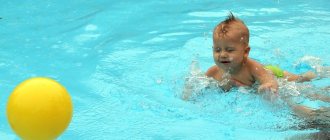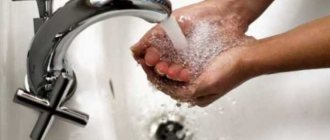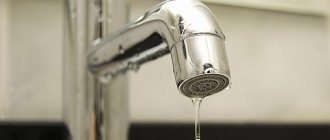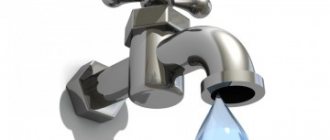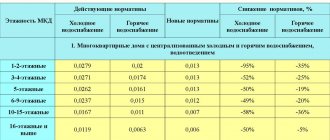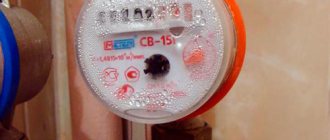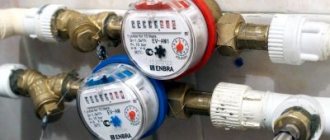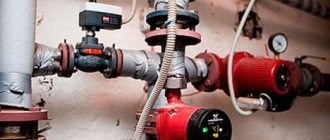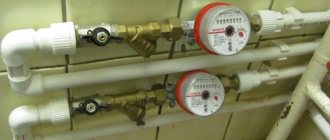Building codes
In the Housing Code of the Russian Federation, in the decrees on pipelines and sewerage, it is stated that those who periodically pay rent for water resources should receive an amount of the resource that will be sufficient for a person’s comfortable living. SNIP states that the composition of the liquid must be safe. And for the liquid to be suitable for drinking, the water supply must meet all sanitary standards.
And if its supply in the house is turned off for more than 4 hours in a row, this is a violation. You can make such an application to the court by attaching the necessary documents. This decree can also be found in the water supply rules of SNIP.
Standards according to GOST
SNIP does not establish exact standards for the temperature of cold tap water, as it may depend on several factors.
- Season. In spring and summer, the temperature of the liquid may be slightly higher than at other times of the year. Since it is at this time that the sun’s rays heat the soil in which the water supply and water intake structures are laid.
- Water supply company. The fact that temperature standards are not specified in legislative and administrative acts allows suppliers to set them themselves. Typically, the minimum temperature threshold for cold tap water is 4 degrees, and the maximum is 20.
The minimum and maximum thresholds will be specified in the contract with the organization supplying the resource. Therefore, you can easily check the company for compliance with the established framework.
A little about the water supply system
The physical parameters of water are also influenced by the technical characteristics of the entire system, which vary depending on the installation method and location.
The city water supply system consists of:
- Pipeline, it consists of risers and conductive pipes.
- Entrance of conductive pipes into the house.
- Certain types of fittings (water intake, mixing, shut-off, control).
- Water meter units.
- Pumps.
- Filters of various types (reverse osmosis, cartridge, flow, jug).
In private households, the water supply system is presented differently:
- Well, well, water tower.
- Pump.
- A container for permanent storage of liquid, this will ensure uninterrupted supply and allow the pump to last longer.
- Various filters for cleaning.
- Piping.
The temperature parameter of cold water in the tap depends primarily on the time of year and region of residence. So in cities that take water from the Volga, the temperature is 25-27 degrees Celsius, and in places where rivers, lakes or reservoirs have a different temperature, the water will be colder or warmer. It varies from 15 to 27 degrees. In winter it is lower, reaching 3-5. It is worth noting that in the pipes through which water reaches the house, the heat may be less (minus 3-4), this is due to the fact that the pressure in the pipes reaches 10 atmospheres, and the crystallization temperature of the liquid decreases with each atmosphere.
According to the standards, the physical parameters of cold water in the tap are acceptable within 4-20⁰C. These standards should be established by housing and communal services or other local authorities; all standards are only recommendations. Exact indicators for 2021 have not been established, as they may change according to SanPin and SNiP standards depending on the time of year and place of residence. Thus, the degree of warmth of water in autumn can be 10⁰ C in September, and 5-6⁰ in October. In fact, the approximate temperature is 9 degrees. If water is supplied by a private company, then the heat is set according to their regulations within the recommended values.
You can independently find out the temperature of the water in your apartment, it should be 9⁰ C. For an accurate measurement, take 2 containers, one larger and the other smaller, but higher. Pour cold water into a large container and place it on the bottom of the sink, then collect the liquid in a small container and place it in a larger one so that the stream flows into the larger container and does not fall into the smaller container. Then place the thermometer in a smaller container and wait 5 minutes.
Possible accidents due to changes in water temperature
Emergency situations with cold water are associated with its warming. It usually warms slightly (less than 10 degrees Celsius). The problem is that the hot and cold water environment at the station coincided. This happens quite often, and a faulty mixer in waterworks is to blame. This device is expensive, so organizations often minimize its importance by not changing it on time.
However, even such a slight excess of the average can have dire consequences. The bottom line is that due to mixing cold and hot, the composition of cold water changes for the worse. Hot water contains slightly more hazardous substances than cold water.
Washing machines using cold water may be damaged due to this excess.
If you notice such violations, you must contact the management organization to resolve the problem. The water temperature must be restored as soon as possible.
DHW temperature
A little about what temperature the water should be. The temperature range of hot water is from 60 to 75 degrees Celsius.
Such values were chosen for a reason. When the water temperature in the tap is higher than the recommended limits, burns are possible, especially to the sensitive skin of a child. Therefore, the standard must be strictly observed in children's institutions and healthcare organizations.
Many tenants are interested in why this temperature value is specific. When determining the temperature regime for the supply of hot water, we proceeded from such a phenomenon as the proliferation of pathological microorganisms. The risk of burn injuries was also taken into account.
The difference in temperature of hot water should be such that harmful bacteria cease to exist, and burns do not occur. Warm fresh liquid is an excellent habitat for Legionella, which is extremely dangerous and multiplies in central water supplies (sewage, heating). For example, not so long ago in the city of Verkhnyaya Pyshma, due to this bacterium, which entered apartments through the water supply, 160 city residents had epidemiological forms of pneumonia, and five people died in the hospital.
In hot water, Legionella functions at different temperatures as follows:
- from 70 to 80 degrees – disinfection process;
- 66 degrees – death in 120 seconds;
- 60 degrees – death in 22 minutes;
- 55 degrees – destruction in five to six hours;
- From 20 to 45 degrees – reproduces well;
- less than 20 degrees - dies.
From this it is clear that hot water must be at a very high temperature, but at the same time, when its value reaches 80 degrees, a burn injury is possible. Therefore, the water in storage tanks is heated to very high temperatures, but is only used in conjunction with cold water.
SanPiN also regulates the quality of the water resource; it must be safe, tasteless and odorless. It is necessary to strictly follow all standards and norms of hot water supply, and if violations are identified, management companies identify the cause-and-effect relationship and eliminate it using available methods.
How to find out how many degrees the temperature of the water in the tap is
If you do not have a special device attached to the source, you can get by with simpler methods. To do this you will need an ordinary household thermometer.
Important! Open the tap and set it to cold. Let the liquid drain for 2-3 minutes. Stagnant water in the water supply is usually located somewhat further than the one that flows out first, so for accurate measurements you should wait time.
Place any container under the faucet that will fit the thermometer. Place it at the bottom of the container. Leave everything in this position until the numbers on the thermometer stop. To ensure the most accurate temperature, it is not advisable to move the bowl.
How to measure temperature
Now a little about how to measure the temperature of hot water in a tap in residential buildings. It should be said that the results of measurements carried out by residents are not proof that management companies provided poor quality utility services.
But in any case, after independent measurement, you can make sure whether the quality of the supplied water meets the conditions that suppliers are required to supply to the apartments of a multi-storey building according to current standards, and the temperature of hot water in the water collection points will also be determined. This is necessary to file a complaint with the relevant authorities when the hot water is not up to standard.
The sequence of independent measurements is as follows:
- You need to open the tap and let the water drain for about three minutes.
- Take any container of at least 1 liter and fill it with water that flows from the tap.
- Take a temperature meter and insert it into the hot liquid closer to the base.
- Wait until the mercury stops on the thermometer and remove it from the container.
From these measurement results it can be determined whether the detected value corresponds to the recommended values. You should know that the measurement is carried out only at the water tap point (where the water comes out of the mixer). No measurements should be taken at other points, since the degrees drop there, and this is the concern of resource supply and management companies.
As a result, there is no need to provide employees of the management organization with excuses to blame all these issues on the residents of the building, because sanitary standards for the temperature of hot water in apartments are enshrined in the laws, and the causal connections between the owners and tenants of apartments do not concern them. The main thing that residents need is to be aware of who to write an application for recalculation of payments for housing and communal services that were provided poorly.
IMPORTANT! Research that determines the standard temperature of hot water in an apartment should be entrusted to an accredited company that has license certificates authorizing such activities.
Where to go to change the temperature
If residents in the entrance or in the entire house are absolutely dissatisfied with the quality of the water supplied from the water station, they can write a complaint to the organization that supplies it. In order for the act to be accepted, at least 3 people must sign it.
You can learn about the specifics of writing an act from the Management Company. But usually they contain the same information:
- Contract data. The agreement number, full name of the tenant, and the name of the service provided are indicated. The contents of the complaint are then described.
- Proof. In this paragraph, the applicant must indicate the temperature limits established in the contract and the temperature, how many degrees the water is.
- Data about the consumer and contractor. That is: full name, positions, addresses, phone numbers. Then the signatures of both parties are placed, as well as of all residents who agree with the information listed in the act.
Important! If you do not want to write the act by hand, you can print out a special form, which can be found on the administration website, and simply enter the necessary information in the blanks.
If the supplier ignored the act and did not improve the quality of the water, the act is valid and completely reliable automatically.
This way, residents can influence how many degrees the cold water is when irregularities are detected. After all, human health depends on temperature and its quality.
Where to contact
If hot water deviates from current standards, and the quality of the services provided is low, then the apartment owners write a statement to the management company. You need to add an appendix to it in the form of a copy of the examination conducted by an independent organization. After this, all that remains is to wait for the management company to solve this problem, which will take time.
When the management company does nothing or only unsubscribes come in response, then the answer to the question of what to do in case of deviations is that you should move on. To the housing inspection or prosecutor's office. In reality, many tenants often encounter similar situations when the management company does not want to eliminate its shortcomings, but only nods at supposedly objective circumstances.
They often say that they are not authorized to resolve such issues, they are not within their competence, and the management companies are not responsible for the operation of the pipelines. You can also find out that they are not at all aware of what temperature the hot water supply should be at the outlet of the water point, so the management company is not going to do anything to resolve this issue.
It is necessary to firmly defend your own rights, because only management companies are entrusted with the mission of public services. The DHW temperature at a rate of 60 to 75 degrees must be provided by management companies. It is their direct duty to respond to all complaints and eliminate problems. If this is not done, then the owners have the right to file a complaint with the prosecutor’s office and Rospotrebnadzor.
Supervisory authorities
When deviations from hot water standards are detected, the management company negotiates with resource supply organizations, and in some situations repairs the engineering and communication system on its own. It often happens that in order to save money on users, some careless contractors shy away from carrying out pipeline repair work that they are simply obliged to carry out. In this case, you should feel free to complain to the prosecutor’s office or Rospotrebnadzor.
Moreover, you don’t have to forward the complaint to supervisory authorities, as tenants often do. Know that you can always reach an agreement with the management company and recalculate hot water in an amicable way. In practice, many management organizations themselves become hostages of such situations, when literally nothing depends on them.
Before you write an application for recalculation of payment for utility costs due to services provided poorly, you should find out all the intricacies of this issue and study the pitfalls. This must be done in order to avoid getting into various unpleasant situations. Everything can be resolved in a civilized manner and according to the law.
But when all the attempts made have not led to any result, then the owners of residential premises should contact the supervisory structures. Then things will go much faster, and when there is actually a problem situation, it will be solved in a fairly short time.

